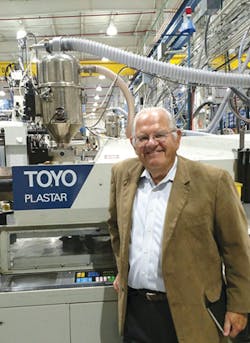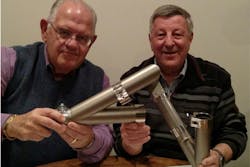Chuck Thiele gets down and dirty
Chuck Thiele is old school.
While much of the plastics processing industry is focusing on Industry 4.0., Thiele is still getting his hands dirty down in the pipes, dealing with problems like angel hair and "spaghetti bowl."
A native of Chicago, he learned the trade from relatives in Germany in the 1960s and then alongside innovators in the American auxiliary equipment industry.
He became a partner of former Motan CEO Walter Kramer, with whom he still is collaborating on new designs for pneumatic conveying and drying equipment.
He recently spoke with Plastics Machinery Magazine senior correspondent Doug Smock.
How did you get into the plastics business?
Thiele: While I was in the U.S. Air Force in the early 1960s, I connected with relatives in Germany who were involved with manufacturing pneumatic conveying and blending equipment for the plastics and chemicals industries. After my enlistment was up, I stayed in Germany and joined Gebrüder Grün (Green Brothers). There I worked for Uncle Gustav as kind of an intern and was introduced to the basics in pneumatic conveying technology in German — before I knew what the heck it was in English. I spent a lot of time with parts lists and a German-English dictionary. That was sort of a baptism by fire. I then went to work for a company called Sprout Waldron, now a part of Andritz Inc. in Muncy, Pa., where I managed the introduction of technology licensed by Grün to Sprout. Here I was very fortunate, as I had some terrific teachers and mentors in pneumatic conveying. In 1973, I went to work at Whitlock Inc. [now part of AEC, New Berlin, Wis.], where I was the national sales manager.
You were awarded your first U.S. patent in 1986 for a vacuum receiver that targeted the difficulty of periodic clogging of filters. How did you make the transition from sales to inventing new technology?
Thiele: I left Whitlock and started my own rep agency in 1976.
As time went on, I began to notice more and more ongoing problems and headaches that were caused by filters and screens that were seriously impacting efficiencies, and I felt that these needed to be addressed.
The basic knowledge I had gained at Sprout was the guide for me, as I evaluated and studied what was happening in vacuum receivers.
It was like a light bulb went off. I figured that if you could decelerate the material as it entered the receiver and convert high incoming velocities to speeds that were insufficient to pick up and convey material, you could eliminate the filter. I built a prototype — and it worked.
For me, the transition from sales to product development seemed natural. Every product that was developed — whether it be a vacuum receiver, purge valve, proportioning valve, material selection and dry air manifolds, etc. — seemed to be "a natural." Ideas seemed to flow. I don't know why, but they still do — and sometimes still keep me awake at night.
The company listed on the patent was something called Kenntnis. What was that?
Thiele: That's something from my German days. Kenntnis means "knowledge" in German. I later took the "ken" from kenntnis and added "vey" from convey and formed Kenvey Inc. I loved the name, but nobody else could figure out what I was talking about. At that time, I hired an engineer to convert my ideas into products and then we started developing and selling systems. We had a small stand at the NPE in 1985, and I met Walter Kramer, CEO of Motan of Konstanz, Germany. Walter was responsible for much of Motan's conveying and drying, and in 1986 Motan and Kenvey partnered. At the time we had sales in the hundreds of thousands of dollars, but that changed pretty fast. The company ultimately became Motan Inc.
What was the focal point of what Motan was doing? What were its contributions to American plastics processing?
Thiele: The whole crux of the growth of the company was the introduction and development of central drying systems in the United States. We knew that this niche was out there to be taken. Central drying, the way we were presenting it, had not been done at all prior to that and it became our primary business. The basic idea was and is to dedicate dryers to materials rather than machines. So, rather than have 10 dryers drying nylon at 10 machines, you had one dryer serving 10 machines.
The central drying systems, coupled with what was at that time the industry's only filterless vacuum receiver, gave us a real edge and allowed us, as a small company, to make a considerable impact on the industry. We didn't make beside-the-press loading or drying equipment. Now every dryer manufacturer offers their own version of a central drying system.
How has the industry changed over the past 40-plus years?
Thiele: Going back to the 1960s when the John Reibs, Dewey Rainvilles and Carl Whitlocks were in the business, there was a tremendous amount of ingenuity and product development from the leadership of the industry. (Note: John Reib was the founder of Conair, Cranberry Township, Pa.; Dewey Rainville founded the Rainville Co., which later bought Una-Dyn, Woodbridge, Va.; and Whitlock was the founder of Whitlock Inc., now part of AEC, New Berlin, Wis.).
Carl Whitlock developed the first Venturi, and he along with John Reib and Dewey Rainville were pioneers in the drying and conveying business. Those guys were a part of what I like to call the Proactive Generation.
The biggest innovations that I see today in the resin-handling/drying segment, with a few exceptions, are mostly coming from Europe or the Far East. It seems that these companies are more likely to invest in new technologies, whether it is in conveying, drying or blending. They seem to be today's Proactive Generation, and it seems that we have become the Reactive Generation, perhaps with the exception of Steve Maguire, who is always thinking how he can do something better.
Industry 4.0 will be a theme at K2016. Is there a digital revolution taking place in resin handling and drying?
Thiele: It seems to me that the most important aspect for the future of what I like to call the material-preparation business (conveying, drying, blending) will be to measure, validate, correct and trace the preparation of every pellet. We tend to think of this now as a critical part of medical molding, but in the future it will also be a part of automotive, electronics and other market sectors. New technologies in some of the new central drying systems are already Internet-enabled, where you can remotely manage some aspects of the conveying process (such as fill time, purge time and destination selection). I think most of the major companies are already doing that. But the key is that is certainly part of the overall evolution. I'm not an electronics or controls guy and my focus is on the basic mechanical technology. If you have a control managing an old technology, then you still have an old technology. The question is, "Where does the technology come from that can really put those controls to the test?" Some people are doing it right with their central drying technology now, and I'm really enthused by that.
What is "the right way"?
Thiele: A key issue in a drying system, in either a dedicated or central system, is controlling and modulating both temperature and the airflow to the drying bin, and modulating that airflow based on the use of the material and the dryness of the material. If the material sees too much heat, it burns and if it sees too much dry air, it can get brittle. The system needs to be able to see, react and adjust airflow and temperature as required to prevent overheating and overdrying. Some of that technology is here now, particularly the over-temp situations, but I am not sure who is capable of adjusting airflow based on moisture content of material exiting the drying hopper.
That modulation of dry air and heat refines the drying process and gives you an end product that is more consistent. If a processor is drying 20 percent glass-filled nylon and it dries at a high temperature for too long, [the nylon] gets discolored. If it dries at [an incorrect] dewpoint too long, it becomes brittle. The issue is how do you read that moisture and then adjust it online.
Where is the technology now?
Thiele: You can measure the moisture content on-stream now, but how you react to that moisture content and how you modulate your system is another thing entirely. I'm not sure how many people are looking at those two things and putting them together.
What are some of the other important issues in resin drying and handling that need to be addressed?
Thiele: The use of highly abrasive glass- and mineral-filled plastics continues to grow rapidly. The glass loading can be from a few percent to more than 50 percent. When you convey that material through a line at velocities of 4,000 feet per minute or more, it eats everything up: manifolds, valves, elbows and vacuum receivers. You can't eliminate the abrasiveness, but you can make equipment that lasts longer. Applying ceramic to the interior of a stainless steel elbow may [extend its life], but the ceramic can chip off and create serious contamination problems in the tool.
Are you also consulting?
I have been doing consulting work in two areas since my retirement from Motan. One is working with major system suppliers like Motan, Conair, Novatec and others where we concentrate on product design, and the other is helping processors like B&B Molders, Mishawaka, Ind., and PPC Industries, Pleasant Prairie, Wis., who are working to resolve conveying and drying problems.
How would you like to be remembered?
Thiele: I think we did some pretty important work in both conveying and drying that changed the ways people looked at and thought about how to design conveying and drying systems, and that positively impacted the industry.
The most important part of all that is the we. Nobody, certainly not me, builds a company, designs products and systems and creates a national image alone, and I'm very proud that we had a terrific group of young people that we developed at Motan. Many had no idea about the plastics industry, let alone conveying and drying, when they began, but they became totally wrapped up in the technology and made things work. I am happy to say that many are recognized as experts in today's central drying and conveying business. That's really the thing that I'm most proud of.



